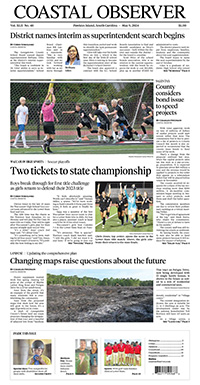Tourism
Festival has eye on a flock that values natural resources

A bird no bigger than a fist flitted through the marsh grass before settling on the rocks that define the entrance to Murrells Inlet. A dozen pairs of eyes followed its journey, aided by binoculars, spotting scopes and camera lenses of enormous size. They hoped to solve a mystery: Nelson’s sparrow or salt marsh sparrow.
Even Scott Hartley wasn’t sure. He pulled out his phone to consult a birding app, but said he would have to check with someone who knew more than he had gleaned during his 27-year career with the North Carolina State Parks or the dozen years he spent as a volunteer guide at Myrtle Beach State Park.
Either species would be a new sighting, said several of those on the hike to the Murrells Inlet jetties that was part of the Hammock Coast Birding Festival over the weekend.
The second annual event drew 100 people from around the region and across the country for tours, talks and a chance to share their experiences.
“Birders are the nicest people,” said Kathleen Acker, who came from Long Island, N.Y., as part of a visit to her parents in Surfside Beach.
The festival was her first birding experience. She carried her father’s old binoculars.
Although she has been to the area many times, she said the trips to the Yawkey Wildlife Center on South Island and Hobcaw Barony gave her a deeper appreciation for Georgetown County.
Mark Stevens, the tourism development director for the Georgetown County Chamber of Commerce, wasn’t surprised to hear Acker’s assessment. He’s heard it from others.
“These are some of the nicest people I’ve ever met,” he said.
The idea behind the festival is to attract winter visitors. It’s the one season that still has ample acommodations space available.
Although the numbers aren’t large, Stevens said they provide a way to reach a valuable market.
“We get a huge amount of word-of-mouth from this,” he said. “We think they are very vocal about what they see.”
Candy Morgan of Pittsburgh came to the inaugural festival last year. She keeps what birders call a “life list” of the species she has seen. By the second day of the festival she had already added three birds to her list and was on a waterfowl tour at Huntington Beach State Park when she spotted a fourth: a sora, also known as the Carolina rail.
That pretty much summed up her reason for returning. “I’ve learned to identify waterfowl better and seen a life bird,” Morgan said.
Cindy Aulbach was something of a rarity herself. She lives in Belle Isle south of Georgetown. She came to the festival for the second year with two of her sisters. Although she’s a long-time birder, “I’ve learned so much,” Aulbach said.
Ceclia Greenman of Littleton, Colo., tried to register for last year’s festival, but it was sold out. She had better luck when registration for this year’s event opened last fall and combined the trip with a visit to her brother in Wilmington, N.C.
Greenman was among those studying the sparrow at the Murrells Inlet jetties after a 1.5-mile hike along the beach. Whichever species it turned out to be would a first for her, she said.
Hartley, who led the tour, kept a close watch on the time, pausing during the walk to point out a bald eagle perched in the top of a dead tree along the marsh and a passing loon. He wanted to make sure that the participants had a chance to see the full range of habitats and still get back to their vehicles to get to their next tour on time.
That’s part of the challenge of organizing the festival, Stevens said. It’s also a factor as the chamber, which handles tourism marketing for Georgetown County, tries to figure out how the festival will evolve.
This year, workshops on photography and painting were added to the field tours. Those tours average about 20 people, so it would be difficult to increase attendance without increasing the number of locations. The state park and Brookgreen Gardens can host more than one at a time, but Hobcaw and Yawkey are more restricted.
“There’s a lot of logistics to it,” Stevens said.
The Black River Cypress Preserve near Andrews, the Waccamaw National Wildlife Refuge and Sandy Island are areas that would be ideal for birding tours. One of the volunteers suggested a twilight “owl prowl” for a future festival, he said.
The fact that the festival has room to grow in an area that is already known as a birding hotspot shows the importance of land conservation to the tourism economy, Stevens added.
“We really love bringing these people here,” he said. “People who love nature have a different attitude about life.”
As for the bird at the jetties, Hartley determined it was a salt marsh sparrow.
Update: This article has been updated from the print edition, which misidentified Celia Greenman.




